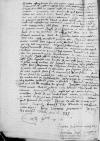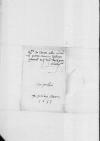An vivus sis, an mortuus, ego profecto coniectura assequi non possum, adeo diu est, quod de te nihil audio, nam neque ad tot litteras meas quicquam rescribis, et dominus ⌊Nyptzitz⌋, amicus noster, in litteris suis ad me nullam penitus mentionem tui facit. Scio ego, cum orig. quum⌈cumcum orig. quum⌉ primum ad tuos venires, indulgendum fuisse pientissimae ⌊matri⌋ tuae, scio, affinibus, amicis, sodalibus, sed tot mensibus, quod nihil scripseris, ignoscere vix possum. Si vero, ut alibi, ita apud vos invaluit incivilis consuetudo litteras aperiendi, forte potest fieri, ut meas omnes non acceperis, tametsi quasdam ad ⌊reverendissimum Pzremisliensem⌋, alias ad ⌊Foccharos⌋ dederim et ⌊Carolum Cutzer⌋.
cf. Cic. S. Rosc. 76.1; 132.1 Verum ut haec missa faciam ⌊Sed haec missa faciamuscf. Cic. S. Rosc. 76.1; 132.1 Verum ut haec missa faciam ⌋ et, si potes, rescribe, si non potes per chiragram orig. chyragram⌈chiragramchiragram orig. chyragram⌉, iube ⌊Campensi⌋ aut alicui alteri ex amanuensibus, nam miro teneor desiderio orig. desyderio⌈desideriodesiderio orig. desyderio⌉ cognoscendi de valetudine tua.
Nos hic recte valemus fuimusque in ⌊Posonio⌋ congressi cum ⌊vayvodanis oratoribus⌋, resque serenissimi ⌊Ferdinandi regis⌋ optima in spe sunt. ⌊Imperator Thurcarum⌋ mittit ad serenissimum ⌊regem⌋ praefatum oratorem unum insignem, qui de hora in horam hic ⌊Viennae⌋ exspectatur orig. expectatur⌈exspectaturexspectatur orig. expectatur⌉. Interim indutiae orig. induciae⌈indutiaeindutiae orig. induciae⌉ sunt, quae optime servantur. Scribitur et ex ⌊Constantinopoli⌋ longam et firmam pacem eundem orig. eumdem⌈eundemeundem orig. eumdem⌉ ⌊caesarem Thurcarum⌋ nobiscum facere velle. Haec dieta propter adventum praefati oratoris dilata est, donec, quid rei sit, quod afferet orig. adferet⌈afferetafferet orig. adferet⌉, intellexerimus.
Christianissimus ⌊imperator noster Carolus⌋ ultima Februarii recessit ex ⌊Bononia⌋ profecturus ⌊Alexandriam⌋ ibidemque exspectaturus orig. expectaturus⌈exspectaturusexspectaturus orig. expectaturus⌉, donec classis parata fuerit paper damaged⌈[t]t paper damaged⌉. Reverendissimus ⌊archiepiscopus Barensis⌋ nunc est cardinalis creatus. Liga nova in ⌊Italia⌋ est facta et ordinati milites pro conservatione Italiae. Cuius ligae capitaneus generalis est dominus ⌊Antonius de Leyva⌋. ⌊Pontifex⌋ misit breve apostolicum in ⌊patriam⌋ nostram et iussit episcopis ⌊Morinensi⌋ et ⌊Tornacensi⌋, ut valvis templorum affigerent, quo brevi declaratur ⌊rex Angliae⌋ excommunicatus, nisi ⌊uxorem⌋ repudiatam recipiat. Iamque fama est ⌊Scotos⌋ bellum adversus ⌊Anglos⌋ parare. Quicquid sit, equidem nescio. In ⌊Germania⌋ omnia sunt valde tranquilla. Fama est ⌊caesaream maiestatem⌋ autumno futuro stabilitis rebus ⌊Hispaniarum⌋ traiecturam in ⌊regnum Neapolitanum⌋ una cum ⌊imperatrice⌋ et ibidem sedem imperii posituram.
⌊Hieronymus Sayler⌋ valde miratur, quod nihil de te audit. Dominus ⌊Godtscalcus Saxocarolus⌋ sese ex animo Reverendissimae Dominationi Tuae commendat. Secuturus est ⌊caesarem⌋ in ⌊Hispanias⌋. ⌊Hunc⌋ meo loco substitui, ut negotia serenissimae ⌊reginae vestrae⌋ sollicitet, id, quod facit et fecit. Ceterum praefata serenissima ⌊regina⌋ per litteras me consulit, num sit melius, ut ipsa aliquem ad ⌊caesa paper damaged⌈[a]a paper damaged⌉rem⌋ mittat, ex quo, ut ait, ⌊Godtscalcus⌋ non est caesari gratus. Nescio, quis de ⌊Godtscalco⌋ ita ⌊ipsam⌋ informavit, neque enim indiligentem sese praestitit et apud ⌊caesarem⌋, et magnates gratiosus est, et gratiosior quovis, quem illa mittet, te uno, dico, excepto, nam ⌊Fabianum⌋ optime novi et
cf. Cic. Leg. 3.29.3; Cic. Tusc. 5.12.4; Cic. Fam. 7.17.1 pace tua dixerim; Cic. Mil. 103.10 pace tua, patria, dixerim; Ov. Pont. 3.1.9 pace tua dixisse velim ⌊pace tua dixerim paper damaged⌈[im]im paper damaged⌉cf. Cic. Leg. 3.29.3; Cic. Tusc. 5.12.4; Cic. Fam. 7.17.1 pace tua dixerim; Cic. Mil. 103.10 pace tua, patria, dixerim; Ov. Pont. 3.1.9 pace tua dixisse velim ⌋, animo est excelsiore, quam ut sese demittere possit in molestias nostras. Scis paper damaged⌈[cis]cis paper damaged⌉, quid velim. Ego tamen consulo ⌊reginae⌋, ut aliquem mittat, et sic experietur, nam ego adhuc maneo in ista legatione. Quod quamdiu sit futurum, nescio, et ea finita transibo in ⌊Flandriam⌋, et inde, si res exigant aut volet paper damaged⌈[et]et paper damaged⌉ ⌊caesar⌋, in ⌊Hispanias⌋. Reverendissimus dominus ⌊archiepiscopus Lundensis⌋ collega meus per paper damaged⌈[r]r paper damaged⌉ ⌊Italiam⌋ fortassis repetet ⌊Hispanias⌋, nisi bella obstiterint. ⌊Is⌋ se ex animo tibi paper damaged⌈[i]i paper damaged⌉
 UB H 154, f. 112v
commendat offertque servitia sua tum intuitui veteris consuetudinis, tum quod fateatur paper damaged⌈[tur]tur paper damaged⌉ se plurimum debere tibi. Si quid in ⌊Hispaniis⌋ actum voles, tutissime per ⌊eum⌋ agere poteris. Mitto ad te ⌊⌋ ex ⌊Hispaniis⌋ missas, scis, ⌊cuius⌋ sint. Nihil exinde est rerum novarum.
UB H 154, f. 112v
commendat offertque servitia sua tum intuitui veteris consuetudinis, tum quod fateatur paper damaged⌈[tur]tur paper damaged⌉ se plurimum debere tibi. Si quid in ⌊Hispaniis⌋ actum voles, tutissime per ⌊eum⌋ agere poteris. Mitto ad te ⌊⌋ ex ⌊Hispaniis⌋ missas, scis, ⌊cuius⌋ sint. Nihil exinde est rerum novarum.
⌊Imperatrix⌋ erit ⌊Barchinone⌋ ad istud festum Paschatis,[1] credo ⌊caesarem⌋ ante Pascha ⌊ibi⌋ futurum, tametsi fama est et rationi conformis videtur paper damaged⌈[ur]ur paper damaged⌉ eum non nisi in festis Paschalibus abiturum e ⌊Genua⌋. Si quid acciderit nobis paper damaged⌈[s]s paper damaged⌉ in ⌊Germania⌋ existentibus, libens te faciam certiorem, modo vivere intelligam. Nam nisi rescripseris, ego arbitrabor mortuum esse et hunc dolorem quod nolit ⌊Nyptzitz⌋ mihi communem facere.
Quia principio spes erat me in ⌊Poloniam⌋ venturum, scripsit ad me ⌊uxor⌋ mea et ⌊Marcus Laurinus⌋ frater, se ut tibi commendarem. Id nunc per litteras facio. Dominus ⌊de Fiennes⌋ mortuus est, ⌊domina de Egmondt⌋ habet controversiam cum illius ⌊vidua⌋ resque processit ad graviora verba.
Curia nostra est, ut prius. Locum ⌊Valdesii⌋ habet ⌊Hispanus⌋ quidam, famulus domini commendatoris ⌊Cobos⌋, qui
cf. Adagia 1.4.13 neque natare, neque litteras ⌊neque litteras neque natarecf. Adagia 1.4.13 neque natare, neque litteras ⌋.
Negotium ⌊Iudaeorum⌋ est tale: ⌊Ioannes Vuysting Traiectensis⌋ sollicitat. Captivus ille monoculus, qui fuit apud ⌊Tridentum⌋, deductus est ⌊Bononiam⌋, post examen inventus reus. ⌊Hispani⌋ praeter don ⌊Garciam de Padilla⌋ commendatorem de Calatrava dicuntur illi favisse. Ipsa illustrissima ⌊Sabaudiae dux⌋ ⌊Bononiae⌋ pro nebulone instetit. ⌊Caesar⌋ respondit exposita vita furciferi se non posse quicquam contra iustitiam in gratiam cuiusquam concedere. Sic ⌊Ioannes⌋ triumphat et, ut ⌊Godtscalcus⌋ noster scribit, destinatus est ⌊Vespasiano⌋ successor adversum ⌊Iudaeos⌋ et contra eos moturus ex ⌊Alexandria⌋, quo sequitur ⌊caesarem⌋. Ego enim nihil amplius scribo, quam idem ⌊Saxocarolus⌋ ad me scribit.
Quid de me futurum sit, incertus sum. Taedet orig. Tedet⌈TaedetTaedet orig. Tedet⌉ me huius vitae. ⌊Doctor Mathias⌋ fit intolerabilis et waltkirchisat,[2] ⌊Obernburger⌋ est secretarius. Ego ubique excludor. ⌊Pratensis⌋ redibit in ⌊Flandriam⌋. ⌊Barensis⌋ est cardinalis. Scis, quid ⌊dominus de Nassaw⌋ de ⌊Osmensi⌋. Ita praeter ⌊Cobos⌋ et ⌊Grandvellam⌋ nemo manet, res tamen procedunt mira felicitate orig. foelicitate⌈felicitatefelicitate orig. foelicitate⌉. Tantum potest Dei voluntas. ⌊Hieronymus Lasky⌋ apud vos est, poterit is plura recensere. Scribe ad me duabus viis, altera per ⌊Focharos⌋, altera per naves ad ⌊Brugas⌋ aut ⌊Zelandiam⌋ semisubmersam. Nam quid facturus sim, nescio. Ego me ex animo tibi, ⌊sororibus⌋[3] tuis, amicis, ⌊Campensi⌋, ⌊fratribus⌋ omnibus commendo et rectissime valere cupio.
 UB H 154, f. 112v
commendat offertque servitia sua tum intuitui veteris consuetudinis, tum quod fateatur paper damaged⌈[tur]tur paper damaged⌉ se plurimum debere tibi. Si quid in
UB H 154, f. 112v
commendat offertque servitia sua tum intuitui veteris consuetudinis, tum quod fateatur paper damaged⌈[tur]tur paper damaged⌉ se plurimum debere tibi. Si quid in 

